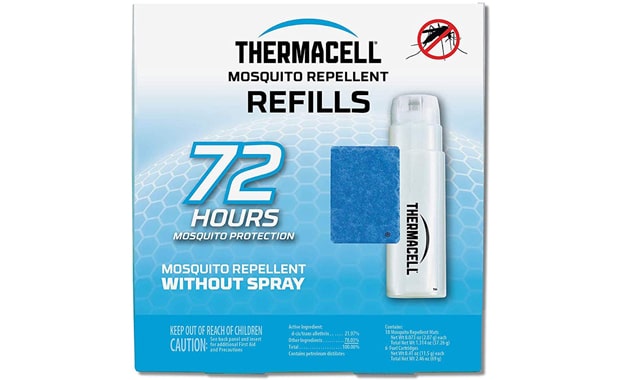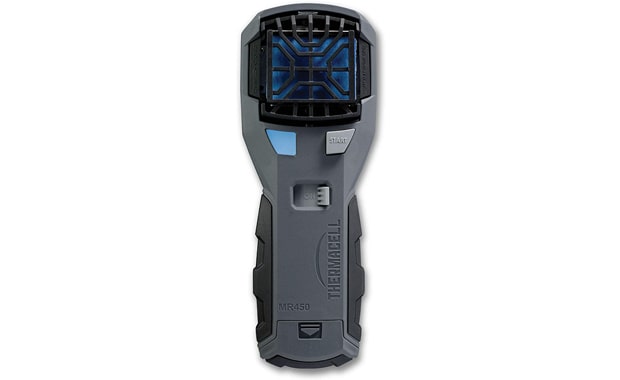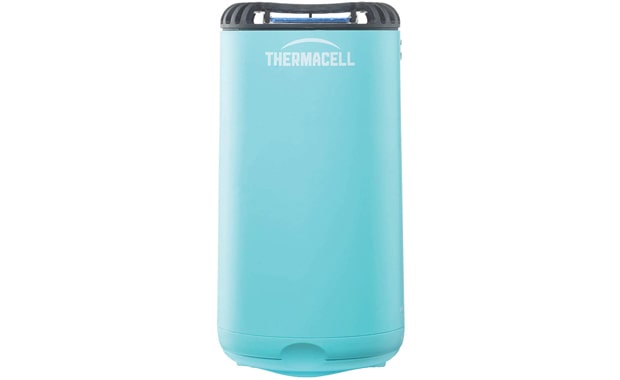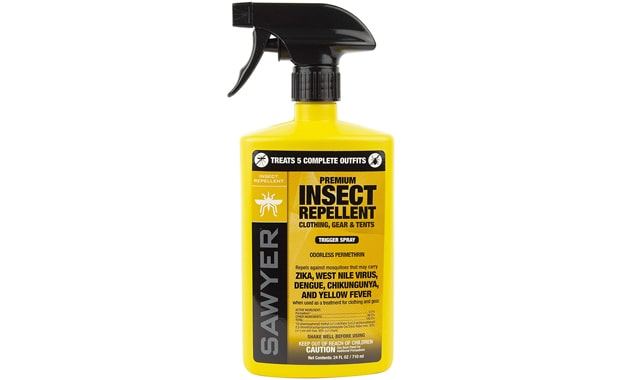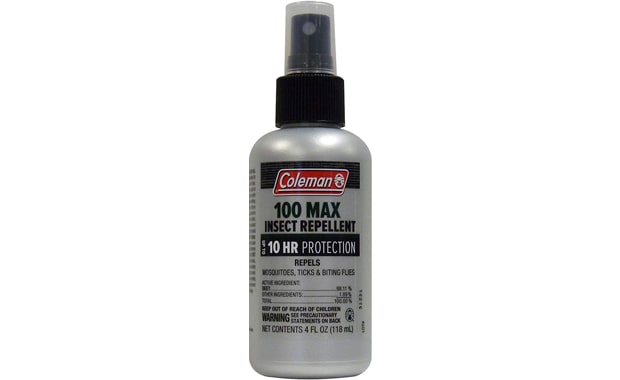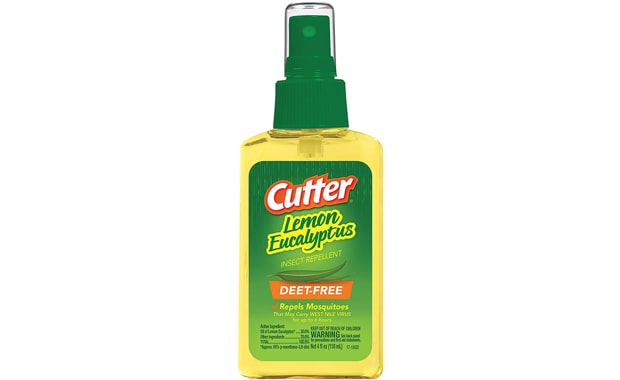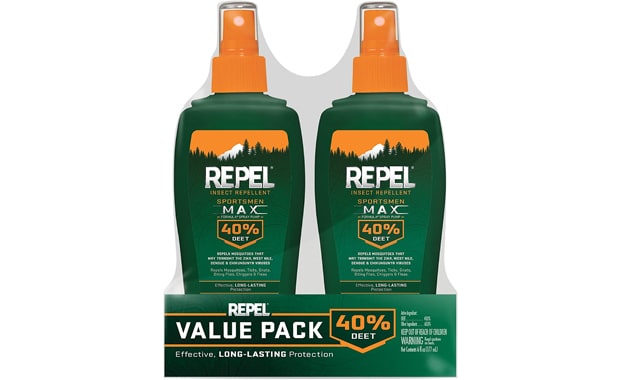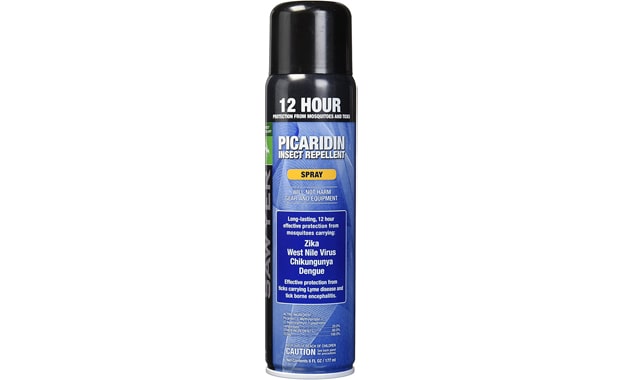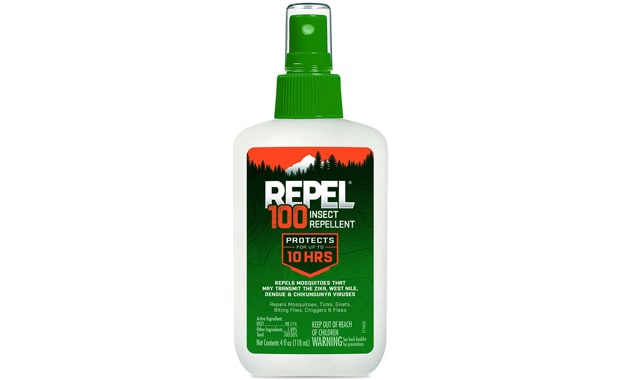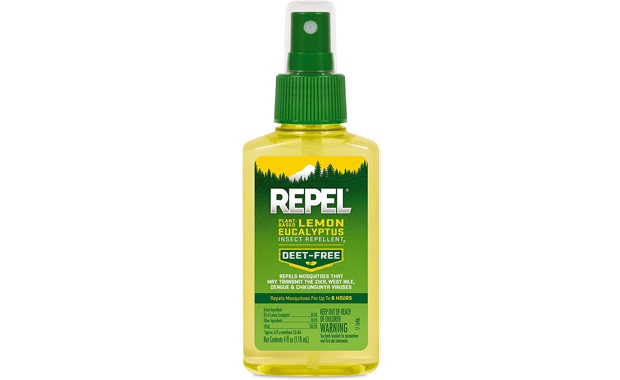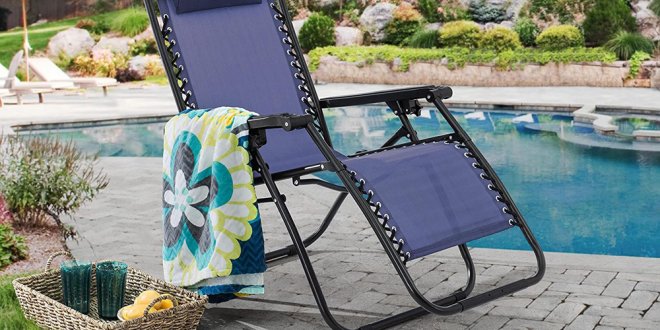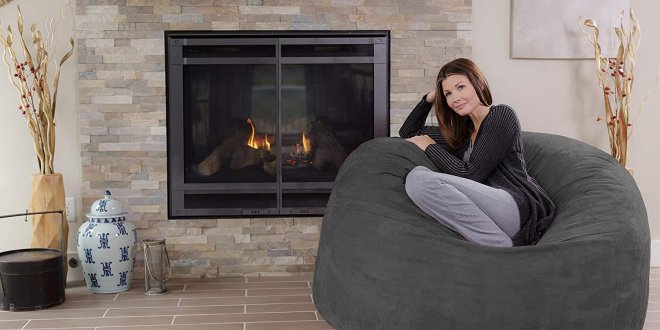With the arrival of summer, we all look forward to enjoying some outdoor living during those long, warm evenings.
However, once you start to relax on your patio or deck, your enjoyment may soon be disrupted by the arrival of annoying mosquitos. Mosquito repellents are one way keep these pesky insects from ruining your summer fun, but with such a bewildering array of choices on the market, it can be hard to choose the best mosquito repellent to suit your needs. Repellents feature different active ingredients, for instance, Permethrin, Picaridin or DEET, or natural options such as oil of lemon eucalyptus. Repellents also come in a variety of formats including cream, spray, stickers, and bracelets. There are also mosquito repellent devices to consider such as Thermacell. Read on to learn how to select the best mosquito repellent for you and your family.
Related:The 11 Best Mosquito Killers
Thermacell Mosquito Repellent Refills
Thermacell Mosquito Repellent Refills includes 18 repellent-infused mats and 6 fuel cartridges for use in any of the various Thermacell repeller devices. The active ingredient in the repellent mats is an allethrin, a synthetic chemical repellent that has a great advantage over some other synthetic chemical options in that allethrins have low toxicity to humans. The Thermacell concept is an infusion of an area with repellent, an added advantage for those reluctant to risk the toxicity or damage by applying chemical repellents directly to skin or clothing. The Thermacell method does not involve any messy sprays or smoke either and has the added plus that the repellent has virtually no odor. However, this product is not completely free of toxicity, so it is still important to carefully follow the safety precautions on the packaging.
Thermacell products are also less effective when the air is moving, and both the mats and cartridges need a regular replacement for the devices to remain effective. All that said, the Thermacell family of products is recognized as a relatively safe and effective option for enjoying your outdoor space bug-free.
- No DEET or on-skin chemicals
- Long-lasting
- Highly effective
- Work with any fuel-powered Thermacell repeller
- Portable and easy to use
- Brand: Thermacell
- Product dimensions: 5 x 2.2 x 5.2 in.
- Product weight: 8 oz.
- Active Ingredient and concentration: d-cis/trans allethrin 21.97%
- Format: Repellent mat for use in repeller device, lantern, or torch
- No scent, no spray
- Highly effective
- Mats need regular replacement, can be expensive to run
- Somewhat toxic if ingested, exercise caution near food and drink
Thermacell MR450 Armored Portable Mosquito Repellent
The Thermacell MR450 Armored Portable Mosquito Repellent features a rugged device that uses Thermacell allethrin-infused mats to create a personal bug-free zone for those enjoying active outdoor pursuits, from gardening to hiking or hunting. Lightweight and featuring a durable casing, rubber grip, and belt clip, it is designed for ease-of-use in rugged conditions. The LCD display allows convenient monitoring of performance. Like all Thermacell devices, this device creates a 15 foot by 15-foot zone of protection from mosquitoes, without the mess of sprays, smoke, or flames. However, it also has the same limitations as other Thermacell products: it is less effective when the air is moving, and the mats and cartridges do need regular replacement. Even with these provisos, this Thermacell device is still a convenient and effective bug-control option for those planning an outdoor adventure.
- 5-foot area of protection, effective
- No on-skin chemicals or sprays: scent-free and DEET-free
- Easy to use, portable, durable
- Brand: Thermacell
- Product dimensions: 2.5 x 3 x 7.8 in.
- Product weight: 6.6 oz.
- Active Ingredient and concentration: uses Thermacell mosquito repellent mats containing d-cis/trans allethrin 21.97%
- Format: Handheld repeller device with belt clip
- No scent, no spray, no mess
- Portable, easy to use
- Durable
- Requires fuel refills, repellent refills
- Effectiveness reduced by movement, moving air
Thermacell Patio Shield Mosquito Repellent
The Thermacell Patio Shield Mosquito Repellent features a device that uses Thermacell allethrin-infused mats to create a bug-free zone for those enjoying a relaxed outdoor space on a deck or patio. With its sleek and stylish glacial blue casing, this device blends discretely into your outdoor living décor while creating a 15 foot by 15-foot dome of protection from mosquitoes. Without the mess of sprays, smoke, or flames, the Patio Shield provides a virtually odorless solution to the annoyance of mosquitoes. This device does have the same limitations as any other Thermacell product: it is less effective when the air is moving, and the mats and cartridges do need regular replacement. That said, the Patio Shield is an attractive alternative to more conventional smelly and messy repellents.
- A 15-foot area of protection, effective
- No on-skin chemicals or sprays: scent-free and DEET-free
- Easy to use, portable, durable
- Brand: Thermacell
- Product dimensions: 3.25 x 3.25 x 9.1 in.
- Product weight: 9.6 oz.
- Active Ingredient and concentration: uses Thermacell mosquito repellent mats containing d-cis/trans allethrin 21.97%
- Format: Portable decor-compatible repeller device
- No scent, no spray, no smoke
- Portable, easy to use
- Sleek, décor-compatible casing
- Requires fuel refills, repellent refills
- Effectiveness reduced by movement, moving air
- Some caution near food or drink
Sawyer Products Premium Permethrin Clothing Insect Repellent
Sawyer Products Premium Permethrin Clothing Insect Repellent is a spray product designed for treating clothing and gear. The active ingredient in this pump spray is permethrin, a synthetic chemical repellent that has a great advantage over some other synthetic chemical options in that permethrin has low toxicity to humans (although it is toxic to bees and fish). Not only is it highly effective in repelling mosquitoes and other biting insects such as ticks, chiggers, and mites, it is long-lasting, remaining effective on treated clothing for up to 6 weeks or 6 washes. This repellent is also safe to use on clothing and gear as it does not stain or damage fabrics, plastics, or finished surfaces. This 24-ounce spray bottle is enough to treat up to 8 garments. This Sawyer repellent is an ideal choice for those seeking to enjoy active outdoor pursuits bug-free but without messy, smelly sprays.
- For use on clothing, tents, and other gear
- Effective against mosquitos including Zika-transmitting Yellow Fever mosquito, also ticks, chiggers, mites
- Lasts on clothing up to 6 weeks
- Does not stain or damage clothing, fabrics, plastics, finished surfaces
- 4 oz. non-aerosol pump bottle
- Brand: Sawyer
- Product dimensions: 9 x 3 x 3 in.
- Product weight: 1.1 lbs.
- Active Ingredient and concentration: permethrin 0.5%
- Format: 24 oz. pump spray
- Effective against mosquitos and other biting insects
- Long-lasting
- Odorless, will not stain or damage clothing or gear
- For use on clothing and gear, topical repellent may be additionally required
- May require frequent refills: 24 oz. treats no more than 8 garments
Coleman DEET Insect Repellent Pump for Ticks and Mosquitos
This Coleman Max 100% DEET insect repellent pump spray may come in a small bottle, but it packs a lot of bug-repelling power. With a 98.11% concentration of DEET, its active ingredient, this product protects against mosquitoes as well as a host of other biting insects, including chiggers, biting flies, gnats, ticks, and fleas. What is more, this repellent is long-lasting, with one application staying effective for up to 10 hours. Its easy-to-carry 4-ounce pump spray format makes Coleman Max an excellent choice for those heading on a backwoods adventure or any expedition where you expect to encounter a high density of mosquitoes or other biting insects.
- 00 % DEET
- Low odor
- Convenient travel size
- Protects against mosquitos, chiggers, biting flies, gnats, ticks, and fleas
- Brand: Coleman
- Product dimensions: 2 x 2 x 6 in.
- Product weight: 4 fl. oz. net
- Active Ingredient and concentration: DEET 98.11%
- Format: 4 oz. pump spray
- Highly effective repellent due to the concentration of DEET (~100%)
- Very convenient format: small non-aerosol spray
- Long-lasting
- Can stain clothing
- Slightly too large to be allowed in air travel carry-on
- Not suitable for those concerned about DEET toxicity
Cutter Lemon Eucalyptus Insect Repellent
For those concerned about the toxicity of DEET and other synthetic repellents, Cutter Lemon Eucalyptus pump spray is an effective alternative for protection against mosquitoes, ticks, and other disease-bearing biting insects. Because this repellent is derived from the leaves of the Lemon Eucalyptus tree, it has a fresh, clean scent and never feels oily or greasy. One application of this product lasts up to 6 hours, and it can be reapplied up to twice per day. Lemon Eucalyptus does not damage or stain clothing or other surfaces, as some synthetic repellents do. It is important to treat every bit of exposed skin to ensure full effectiveness. This Cutter repellent is an excellent choice for travelers and adventurers seeking safe, convenient, and effective protection from mosquitoes, without any smelly, messy sprays.
- DEET-free, active ingredient oil of lemon eucalyptus
- Pleasant lemon eucalyptus scent
- Not oily or greasy
- Lasts up to 6 hours
- Brand: Cutter
- Product dimensions: 1.26 x 2.11 x 5.68 in.
- Product weight: 5 oz.
- Active Ingredient and concentration: oil of lemon eucalyptus 30.0%
- Format: 4 oz. pump spray
- DEET-free
- Fresh scent
- Clean, non-greasy feel
- Long-lasting
- Non-aerosol
- Very strong odor
- Must apply to all exposed skin to be effective
Repel Insect Repellent Max Spray Pump
This two-pack of pump spray 6 ouncers of Repel Sportsmen Max is excellent value. This product boasts a 40% DEET formulation which repels mosquitoes and other biting insects for up to 8 hours. The easy-to-carry 6-ounce format makes it convenient for long-lasting protection for many kinds of outdoor adventures, including camping, backpacking, golfing, hunting, biking, hiking, jogging, and other sports. Just be aware that this repellent, like all products that contain DEET, may damage or stain some surfaces, and may leave you feeling sticky and greasy. This Repel product offers users a high degree of protection, but with reduced toxicity and odor.
- 0% DEET
- Repels mosquitoes, ticks, gnats, biting flies, chiggers, and fleas
- Provides up to 8 hours of protection
- Brand: Repel
- Product dimensions: 1.44 x 5.26 x 7.5 in.
- Product weight: 13.6 oz.
- Active Ingredient and concentration: DEET 40.0%
- Format: two-pack: 2 x 6 oz. spray pump
- Effective (40% DEET)
- Long-lasting
- Easy to apply
- May damage some surfaces
- Strong odor
Sawyer Products 20% Picaridin Insect Repellent
This active ingredient in this repellent is 20% picaridin, a synthetic compound that mimics the essential oil found in black pepper. Those concerned about the toxicity of DEET often find picaridin an effective alternative.
One application of this spray is effective against mosquitoes and ticks for up to 12 hours, and up to 8 hours against biting flies, gnats, chiggers, and sand flies. This picaridin repellent provides all this long-lasting protection while being safe for use on your whole family. You can also use this product on clothing and gear, including backpacks, fishing line, firearms finishes, and synthetic fabrics, without risk of staining or damaging the surface. For many consumers, Sawyer Picaridin Insect Repellent proves to be an effective alternative to more toxic DEET-based products and with none of the drawbacks.
- lasts up to 12 hours
- DEET-free
- Does not damage surfaces
- Fragrance-free
- Brand: Sawyer
- Product dimensions: 3 x 6 x 9 in.
- Product weight: 6.1 oz.
- Active Ingredient and concentration: Picaridin 20.0%
- Format: 6 oz. spray
- Safe to use for the whole family
- Long-lasting
- Does not harm clothing or gear
- Low odor
- To maintain effectiveness, great diligence about reapplication is required
- Some consumers find product ineffective against tropical mosquitoes
Repel HG-94108 100 Insect Repellent
Repel 100 Insect Repellent takes its name from its high “100%” concentration of DEET. It is highly effective even in heavily infested conditions at repelling all kinds of disease-carrying mosquitoes, as well as ticks, gnats, biting flies, chiggers, and fleas. An application of Repel 100 provides this superior protection for up to 10 hours. Because of its compact 4 oz format, this pump spray product is the perfect size to pack when heading out on some great outdoor adventure. As with all DEET-based products, be mindful that its toxicity makes it unsuitable to use on small children and all users should exercise appropriate precautions. Many consumers also find the smell of DEET-based products unpleasant, the feel of it too oily on their skin, or find that it damages surfaces. Nonetheless, for those venturing into heavily mosquito-infested conditions or traveling to tropical locations, Repel 100 provides convenient, unmatched protection.
- Repels disease-carrying mosquitos, ticks, gnats, biting flies, chiggers, and fleas
- 8.11% DEET provides protection in severe conditions
- Protects for up to 10 hours
- Pump spray
- Brand: Repel
- Product dimensions: 2.47 x 1.17 x 6.04 in.
- Product weight: 4 oz. net
- Active Ingredient and concentration: DEET 98.11%
- Format: 4 oz. pump spray
- Effective in heavily infested conditions
- Effective against multiple kinds of biting
- insects Long-lasting
- May damage some types of fabric
- Not suitable for very young children
REPEL Plant-Based Lemon Eucalyptus Insect Repellent
For consumers wary of the toxicity of most synthetic repellents, this plant- based Repel product offers a refreshing alternative. In a convenient pump spray format, its fresh scent and clean feel make it pleasant to use. However, the consumer gets all of these advantages without sacrificing effectiveness, because this repellent still provides a high degree of protection in most settings for up to 6 hours. Easy to carry, easy and pleasant to use, and highly effective, this Repel Lemon Eucalyptus spray is a great repellent choice for families looking to enjoy bug-free outdoor fun
- DEET-free, made with oil of lemon eucalyptus
- Effective for up to 6 hours
- Refreshing scent
- Repels disease-carrying mosquitoes
- Not greasy or sticky
- Brand: Repel
- Product dimensions: 2 x 1 x 5.5 in.
- Product weight: 4 oz. net
- Active Ingredient and concentration: oil of lemon eucalyptus 30.0%
- Format: 4 oz. pump spray
- DEET-free oil of lemon eucalyptus
- Refreshing scent
- Not greasy or sticky
- Some consumers have found the product ineffective
- Some consumers find the strong scent excessive
Choosing the Best Mosquito Repellent
With warmer temperatures and longer evenings come summer cookouts, backyard pool parties, and, unfortunately, lots of mosquitos. However, these summer pests bring more than annoying itchy bites and an irritating high-pitched buzz. Mosquitoes are also carriers of some of the most deadly diseases in the world. Even if you have become used to the local mosquitos in your area, traveling can expose you to new types of mosquitoes and all the different illnesses they may be carrying.
Diseases Transmitted by Mosquitoes
Insect repellents do more than just keep you free from mosquito bites and irritation. They are a potent way to avoid mosquito-borne diseases, which exist almost everywhere in the world where mosquitoes live. Effective mosquito repellents can be used to keep away these bothersome parasites that harbor Zika, Dengue Fever, West Nile, Malaria, or any other potentially deadly illnesses.
The World Health Organization declared in 2016 that the Zika virus is rapidly spreading within the Americas, particularly within Latin America, the Caribbean, Puerto Rico, and the southern states within the United States. The disease itself has been linked to serious birth defects and is transmitted primarily through mosquitoes. It is a large public health threat for American citizens, especially for those who are planning to start a family. Proper mosquito repellent use can significantly reduce the risk of contracting the virus by discouraging mosquitoes from biting. The same species of mosquito that carries Zika can also potentially transmit Dengue fever. Some strains of Dengue fever have a mortality rate as high as 50% if left untreated.
Malaria is perhaps the most infamous of mosquito-borne illnesses. In a study done by the World Health Organization in 2016, nearly half of the world’s population is at risk of malaria. For areas that are affected by malaria, the disease is a major cause of illness and death. While considerable success has been achieved in pushing back on the reach of malaria, the actual elimination of the disease still lies in the distant future. Notably, in sub-Saharan Africa, where nearly 90% of the world’s malaria cases occur, the risk of malaria continues to be a potent reality. To keep yourself safe in endemic regions, it is essential to take as many safety precautions as possible, and investing in a proven insect repellent is one of those steps.
West Nile fever is the leading mosquito-borne disease in the United States, one that has spread throughout almost the entire U.S. over the past two decades. There are no vaccines to prevent it nor treatment for those who are infected. About 1 in 5 people who contract the disease develop a fever and other symptoms, with 1 out of 150 of those infected developing a serious, potentially fatal illness. Once infected, the symptoms can range anywhere from a few days of discomfort to several weeks of illness in severe instances.
Mosquito repellents are just one part of a multi-layered strategy to fend off the pests. The key to avoiding mosquito-borne illnesses is staying away from mosquito-infested areas and minimizing any potential exposure to the biting insects. It is also important to cover up –you can wear long pants and long- sleeved shirts when outdoors, to minimize the amount of open skin that mosquitoes can land and bite on. Moreover, most mosquitoes are active only at certain times of day, notably around dusk, so avoiding the outdoors during that time can prevent unnecessary exposure as well.
While humid environments are more fertile breeding grounds for these annoying insects, they can survive anywhere they have access to even tiny amounts of moisture. However, just because the presence of mosquitoes is virtually inevitable, there is no need to suffer through itchy bites, and that irritating high-pitched buzzing. You can reclaim control by following practices that make your yard less attractive and hospitable to mosquitos and their larvae, and by protecting yourself and your yard with the best mosquito repellent.
A good place to start in your campaign against these annoying bugs is to eliminate any standing water from your yard. Mosquitos and their larvae can breed and thrive in remarkably tiny amounts of moisture, so diligence is key in removing or replacing any and every source of water regularly. “Chances are they’re breeding on your property,” says John Silcox, the public safety information officer for the Fairfax County Health Department, speaking of mosquitoes. “So, go around your property, look for potential breeding sites, tip and toss any standing water you see, and do that on a weekly basis.” Beyond the quick rule of thumb of “tip and toss”, the EPA suggests taking the following steps to get rid of potential mosquito habitats:
1. Drain standing water in rain gutters, old tires, buckets, plastic covers, and toys
2. Empty and change the water in birdbaths, fountains, wading pools, rain barrels, and potted plant trays at least once a week.
3. Drain or fill temporary pools of water with dirt.
4. Keep swimming pool water treated and circulating.
In addition to these preventive measures, you can use pesticides approved by the EPA to control mosquitoes in both their adult and larval stages.
After following these steps to prevent mosquitoes from breeding in your yard, choosing effective mosquito repellents can also help you enjoy a bug-free summer. To be clear, the repellents that you spray on your clothes and skin are not the same as the pesticides you use in your yard. The U.S. Centers for Disease Control and Prevention provide guidelines that offer a good roadmap to choosing a safe and effective repellent.
What Are Mosquito Repellents?
Before examining mosquito repellents, we can first look at how mosquitoes find their prey, that is to say, us. Mosquitoes rely on a combination of three factors when searching for a potential target. First, mosquitoes smell their prey. Mosquitoes are attracted to the carbon dioxide emitted every time we exhale, as well as by other bodily odors. The role of odor helps to explain why mosquitoes seem to be more attracted to some people than to others — we all have different odors and varying strengths of scent. Once a mosquito has been alerted by its sense of smell that there may be a meal nearby, it searches for visual confirmation. Having locked on to its human target, the mosquito then relies on thermal signals (body heat) to seek out that perfect landing spot and start to feed.
While most mosquito repellents work by interfering with the mosquito’s sense of smell (although some actually do kill the insects), strong perfumes and aromatics are rarely enough to deter these stubborn insects, We can start with a look at the substances in mosquito repellents that make them effective: the active ingredients.
Active Ingredients
You may not think to read the label before buying an insect repellent, but that would be a mistake. The active ingredient and its concentration matter for both effectiveness and safety. There are hundreds of mosquito repellents available on the market today, using all sorts of ingredients and combinations to try and keep insects away. Mosquito repellents feature an abundance of active ingredients, both natural and synthetic. Fortunately, there are two agencies based in the United States that evaluate how safe and effective bug sprays are, so their recommendations are a good place to begin our search for the best mosquito repellents. The CDC and Environmental Protection Agency (EPA) recommend the four following ingredients: DEET, Picaridin, Oil of Lemon Eucalyptus, and IR3535. Other ingredients, including those such as allethrin and permethrin that mimic the chemical signature of the chrysanthemum flower, are also gaining popularity.
DEET
Known chemically as N, N-Diethyl-meta-toluamide, DEET is a yellowish liquid that repels biting insects when applied to skin or clothing. Originally formulated in the 1940s for the U.S. military, it has been available commercially since 1957.
When evaluating active ingredients, DEET is a repellent in every sense of the word. While it does not kill insects on contact, it does deter them from landing on people. There is still some confusion about how exactly DEET works, but the prevailing hypothesis is that it confuses insects when they get close to the chemical, making it hard for them to land. Another theory is that DEET just simply smells awful to most bugs so that they stay away.
Regardless of how DEET works, it is one of the most widely used active ingredients in insect repellents in the U.S. This is because DEET is so effective —many scientists believe that DEET can be used as the gold standard to measure other repellents against. Testing has shown that DEET-based repellents have consistently ranked among the top-performing insect-repellent products available on the market. DEET is not perfect, however. There are reservations about the overall safety of DEET. While the chemical has been deemed safe in testing when used as directed, there are people who find that DEET causes irritation and itchiness. When too much DEET is used, it can cause something called “DEET poisoning,” which can lead to seizures and even death.In summary, DEET is associated with some of the following limitations and drawbacks:
1. DEET can cause minor skin irritations and rashes. Absolutely do not use DEET on broken skin or eyes. It can be toxic if swallowed.
2. Sprays containing over 10% DEET should not be used on children
3. DEET can melt some synthetics, which can ruin plastic or vinyl products.
Fortunately, the sheer amount of DEET needed to cause serious DEET poisoning is massive. Most cases of DEET toxicity occur when consumers fail to follow instructions (such as by ingesting it). The reality is that for most people suffering DEET poisoning, it is a very mild reaction, that can be treated at home with nothing more than some rest. In the final analysis, the only way DEET poisoning is only likely to occur by completely disregarding the instructions clearly labeled on the container.
Picaridin
Picaridin is a synthetic compound that was first discovered in the 1980s. It was created to closely resemble a naturally occurring compound called piperine, which is produced by the same group of plants that make black pepper. Ever since its discovery, Picaridin has been widely used in Europe and Australia but did not become available commercially in the United States until 2005.
Much like DEET, Picaridin repels insects without killing them. Unlike DEET, Picaridin seems to prevent mosquitoes from sensing people at all. Picaridin-based sprays are typically applied on either skin or clothing, forming a vapor barrier that deters mosquitoes from landing on the surface to which it is applied. Picaridin is completely safe when used in instructed quantities. It is highly recommended to wash your hands if you apply a picaridin-based spray on them, but ingesting a small quantity is harmless to people.
Much like DEET, overuse or improper use of Picaridin-based sprays can cause skin irritation. Studies have shown that proper usage of Picaridin will not cause an increased chance of cancer. Picaridin can cause skin and eye irritation or vomiting, but only in rare cases.
Oil of Lemon Eucalyptus
Unlike both DEET and Picaridin, oil of lemon eucalyptus is a naturally-derived substance that can be used to protect against mosquitoes and other biting insects. Insect repellents containing oil of lemon eucalyptus can be found in different forms, ranging from the familiar insect spray to wearable bracelets. Sprays are to be recommended over wearable repellents, as a spray can more reliably cover vulnerable areas of your body.
Oil of lemon eucalyptus is made from the leaves of the lemon eucalyptus tree. This ingredient became a major player in the mosquito-repellent world in 2015 when researchers did an in-depth comparison of the performance of eight commercial repellents versus non-synthetic methods. The results showed that the only plant- based sprays tested that could compete with DEET and Picaridin’s effectiveness were options that contained Lemon Eucalyptus. Perfumes, essential oils, and other plant-based repellents fell far behind.
One thing to keep in mind is that lemon eucalyptus driven sprays do not measure up when compared against highly-concentrated DEET or Picaridin sprays. In general, a repellent with 30% Lemon Eucalyptus oil performs at a similar level to a 10%-15% DEET solution. Oil of Lemon Eucalyptus also has not been thoroughly tested against mosquito species found elsewhere in the world, so this plant-based spray might not be the best choice if traveling outside the United States.
The major advantage of lemon eucalyptus-based sprays is that they have low toxicity, especially when contrasted to DEET, and there have been no reports of adverse effects from proper use, including virtually no reports of skin irritation. Oil of Lemon Eucalyptus can cause significant eye irritation, however, so make sure to wash out your eyes if a little of the spray mist gets into them!Oil of lemon eucalyptus sprays is best used as short-term repellents.
IR3535
IR3535, which is short for Insect Repellent 3535, is a synthetic repellent that was originally created by Merck in the 1980s. IR3535 functions by befuddling an insect’s sense of smell, allowing its users to pass by undetected by biting insects such as mosquitoes or fleas. IR3535 has been used for over three decades in various commercial products, with an excellent track record in terms of safety. Most users report no discomfort at all. Furthermore, studies have shown that IR3535 is unlikely to have long-term risks for people and is safe for the environment.
Impressively, when pitted head-to-head against DEET, IR3535 produces strikingly similar results in repelling most insects. The area where DEET excels versus IR3535 is against mosquitos found in sub-Saharan Africa, which tend to carry diseases such as malaria, encephalitis, and Dengue fever. When compared to Picaridin, IR3535 also holds its own. There are no specific species of mosquito for which one active ingredient trumped the other.
IR3535 does cause eye irritation if contact occurs, but happily, there are almost no reports of skin irritation from its use.
Pyrethroids
Pyrethroids, for example, allethrin and permethrin, are synthetic forms of a chemical found naturally in the chrysanthemum flower. Pyrethroids have an advantage over other chemical repellents in that they have low toxicity for humans and birds. However, they are highly toxic to fish and other aquatic species, as well as to insects, including slight toxicity for bees at the concentrations typically used for insect control. They are also toxic to cats. In addition to their low toxicity relative to other synthetic insecticides such as DEET, pyrethroids are also sometimes favored because of their low odor.
Number of Active Ingredients Matter
The number of active ingredients in a bug spray can make a great difference. There is such a thing as having too little or too much, which is especially true for DEET-based repellents. While both EPA and CDC have asserted that DEET is safe, repellents that have a high concentration of DEET has been reported to cause side effects such as nausea or skin rash from overexposure. Unless you have already been using DEET for a while and are confident that you will have no reaction to higher concentrations, it is best to start with DEET sprays with a concentration ranging from 20 to 50 percent.
The concentration of active ingredients influences both the efficacy of the repellent and also how long it lasts. Here is a quick breakdown of what the numbers look like.
Active Ingredient Concentration Hours of Protection
DEET 5% -C 10% 2 -C 4 hours
DEET 15% 6 hours
DEET 25% -C 30% 8+ hours
Picaridin 20% 8+ hours
Oil of Lemon Eucalyptus 30% 5-7 hours
IR3535 20% 7-10 hours
Another thing to keep in mind is that some active ingredients have a strong smell. DEET notably does not have the most pleasant of smells, which means higher concentration repellents will smell stronger of DEET. With DEET options higher than 30%, the smell is immediately obvious as soon as it is sprayed.
On the other hand, Picaridin is a compound with an odor that is far less intense than that of DEET, In fact, it often has barely any scent, which means the sprays can smell much less unpleasant when applied. Picaridin-based repellents tend to have a floral type of odor and are generally considered to be far more pleasant to use. Similarly, pyrethroids have very low or no odor at all.
To test how effective and long-lasting an insect repellent is, a standard dose of repellent is applied to a measured area of skin on test subjects’ arms. (The standard dose is determined from the EPA product testing guidelines.) After 30 minutes, the test subjects then place their arms into the first two of four cages of 200 disease-free mosquitoes for five minutes. Testers watch closely to see what happens inside the cage. They count up every time a mosquito lands on a subject’s arm, uses its proboscis (its long mouthpart) to probe the skin in an attempt to find a capillary, or bites the subject’s arm and begins to feed. The testers can tell that the mosquito is feeding by watching for the insect’s abdomen to turn from gray to red or brown.
After five minutes, the subjects withdraw their arms, then repeat the process by placing their arms into the second pair of cages of disease-free mosquitoes of a different species, for another five minutes. The subjects then walk around for 10 minutes, to stimulate sweating; this is to mimic a real-world setting, in which users might be active while wearing repellent. Half an hour later, this procedure is repeated once, and then again once every hour after that until a repellent fails the test, or until 8 hours have passed since it was applied. Failure is a “confirmed mosquito bite” — two bites in one five-minute session inside the cage, or one bite in each of two consecutive 5-minute sessions.
Be wary of “Natural” Repellents
Most insect repellents touted as “natural”typically contain plant oils such as cedar, lemongrass, rosemary, or citronella, and make claims that they are a solution that can keep away mosquitos. However, findings by the CDC and the EPA, as well as testing by others, show that these “natural” active ingredients are often not nearly as effective as the ingredients discussed above. While certain natural or plant-based repellents may work well enough to ward off insect pests from your deck or patio, when venturing into heavily-infested areas such as backwoods, or traveling, especially to tropical or semi-tropical climes, it is worth balancing your concerns about the toxicity of ingredients or other drawbacks against the risks of serious disease, and opting for repellent formulations proven to be highly effective.
Your Choice should not be based Only on Ingredient or Concentration
While it is important to consider ingredients and their concentration in making your mosquito repellent decision, it is not as simple as choosing the most highly effective ingredient or the highest concentration of the active ingredient. Highly effective ingredients can also have downsides, such as toxicity, unpleasant odor or feel, and even stain or damage clothing or other surfaces. A different but less toxic ingredient, or a lower concentration of the active ingredient, may be quite adequate to meet your needs, without the attendant risks. For instance, testing has shown that products with DEET in concentrations of 25 to 30 percent are likely to provide reliable protection. It is important to factor testing information and consumer testimonials into your decision-making so that you choose a repellent that meets your particular needs and considerations. Some top-rated products contain picaridin, but so do some lower-rated ones.
Product Format
Not only is there a wide choice of active ingredients available in mosquito repellent products, but they also come in a multiplicity of formats. Some, such as candles, bracelets, and repeller devices, are designed to create a mosquito-free “bubble” around the user, while others, including sprays, creams, and wipes, are to be used to directly treat skin, and in some cases clothing or other gear, to discourage mosquitoes from approaching and landing. The repellent form can also explain some of the differences in effectiveness: a product in the form of a spray may be rated more highly effective than one containing the same ingredients at similar concentrations in a lotion or wipe form.
Combination sunscreen/insect repellent products are to be avoided, if for no other reason than sunscreen usually requires reapplication typically every 2 hours, whereas such frequent reapplication of a repellent risks overexposure for the user to the potentially toxic chemicals contained in repellent.
How to Apply Insect Repellents
Proper application and use of repellents are essential, both for optimal protection and to avoid possible side effects, including skin or eye irritation. This means:
- Apply repellent only to exposed skin or clothing (as directed on the product label). Never put it on under clothing.
- Use just enough to cover and only for as long as needed; heavier applications do not increase effectiveness and can increase risks.
- Do not apply repellents over cuts, wounds, or irritated skin. When applying to your face, spray first on your hands, then rub in, avoiding your eyes and mouth, and use sparingly around ears.
- Do not allow young children to apply repellent themselves. Instead, apply it to your own hands, then rub it on the child, being mindful of the precautions stated above. Avoid using repellent on children’s hands because of the risk they will transfer it to their eyes and mouths.
- Don’t use near food and wash hands after application and before eating or drinking.
- At the end of the day, wash treated skin with soap and water, and wash treated clothing in a separate wash before wearing again.
- When planning to use repellents on your clothes, note that many repellents can damage leather and vinyl, and some of them stain synthetic fabrics.
Frequently Asked Questions
Q: What smell do mosquitoes hate?
A: Many natural scents that are appealing to humans actually do repel
mosquitoes, including lavender, peppermint, basil, and eucalyptus. Many of these
scents can be worn as an essential oil on your skin to help deter these pesky
pests from biting you.
Q: How do you keep mosquitoes from biting you?
A: 7 ways to prevent mosquito bites
1. Dump out any standing water near your home
2. Keep mosquitoes from getting inside
3. Use mosquito repellent
4. Wear light-colored clothing, especially outdoors
5. Stay indoors during dusk and dawn
6. Wear long-sleeved shirts and long pants
7. Try natural repellents or essential oils known to discourage insects
Q: Is DEET the best mosquito repellent?
A: While DEET is generally regarded as the gold standard of active ingredients
in mosquito repellents, other substances such as picaridin are also highly
effective and may be better suited to your needs.
Q: What is a natural way to repel mosquitoes?
A: Here are 10 natural ways to repel mosquitoes:
1. Eliminate standing water. Mosquitoes lay their eggs in any standing water they can find.
2. Surround yourself with plants that repel mosquitoes. Mosquitoes find their targets using their sense of smell, and there are some smells they do not like, such as catnip, marigolds, and basil.
3. Lavender
4. Lemon eucalyptus oil
5. Rosemary on barbecue
6. Mosquito traps
7. Citronella candles
8. Garlic
Q: Why do mosquitoes always bite my face?
A: Different mosquito species are attracted to different body parts, some to
feet and ankles but others to the head and neck. This preference could be due to
body chemistry, the fact that the nose and mouth exhale carbon dioxide, or just
that the face is easy to access. Mosquitoes may also be attracted by aftershave or
perfume, so it may be worth changing that up if the mosquitoes seem to love your
face.
Q: Can Vinegar keep mosquitoes away?
A: Vinegar can be used to help repel mosquitoes because of its pungent odor. It
can be used to make a mosquito trap or a homemade repellent.
Q: How do I avoid getting bitten by a mosquito while sleeping?
A: Tips to prevent mosquito bites while sleeping
1. Sleep in dimmed light. Mosquitoes can be attracted to a high-intensity light bulb
2. Sleep inside a mosquito net
3. Apply mosquito repellent lotion
4. Use an electrical mosquito repellent
5. High-speed fan.
Q: Does toothpaste help mosquito bites?
A: Toothpaste can help soothe the annoying itch after a mosquito bite. The
menthol flavor from the toothpaste acts as a cooling agent, keeping your mind
distracted from the urge to scratch.
Q: What is the best antihistamine for mosquito bites?
A: For especially itchy and bothersome bites, the application of an
antihistamine cream or gel can provide relief. Look for diphenhydramine in the
ingredients list; products such as Benadryl contain it and can be fairly
inexpensively purchased over-the-counter in pill or cream form.
Q: Which essential oil is best to repel mosquitoes?
A: Several essential oils are useful in repelling insects.
1. For mosquitoes: Citronella, peppermint, lemon, eucalyptus, basil, clove, thyme, lemongrass, geranium, and lavender.
2. For fleas: Cedarwood, citronella, eucalyptus, tea tree, lemongrass, lavender, orange, and pine.
3. For ticks: Rose geranium, juniper, rosewood, thyme, grapefruit, and oregano.
Q: What is the best homemade mosquito repellent?
A: Homemade repellents can be made from various essential oils known to
discourage mosquitoes. Here are some examples:
1. Lemon eucalyptus oil
2. Peppermint oil and coconut oil
3. Neem oil and coconut oil
4. Apple cider vinegar and essential oil spray
5. Tea tree oil and coconut oil
6. Citronella oil and alcohol spray
7. Cinnamon oil repellent
8. Lavender oil, vanilla, and lemon juice
Q: Why do mosquitoes like to bite ankles?
A: Mosquitoes locate their target using their sense of smell, so the smell of
feet may attract them. Ankles may also be more exposed and easier for the
mosquitoes to access.
Conclusion: What to Keep in Mind When Selecting a Mosquito Repellent
With such a wide variety of insect repellents to choose from, there are a few things to keep in mind when considering your options. While DEET is widely recognized as the most highly effective active ingredient found in mosquito repellents, different concentrations of DEET are suitable for different uses, and there are several other active ingredients, such as picaridin, oil of lemon eucalyptus, IR3535, and pyrethroids, that have also been found to be highly effective in many settings and which may be better suited to your needs. By considering both the active ingredient and its concentration in your decision- making, you will choose the product that features an ingredient at a concentration that will do the job that you need to be done, without entailing unnecessary downsides, such as toxicity, excessive or unpleasant odor, unpleasant feel, or potential side effects, or damage to clothes or gear. Be wary of “natural” or plant-based repellents, because with the exceptions already noted (such as oil of lemon eucalyptus), they typically do not work as well as the synthetic options.
It is also important to consider the format that works best for your purposes: spray, lotion, repeller device, or some other format. Finally, avoid combination sunscreen and insect repellent products – they are problematic. Follow these guidelines, and you can look forward to enjoying your summer outdoor experiences comfortable and bug-free!
 Best Wiki
Best Wiki

